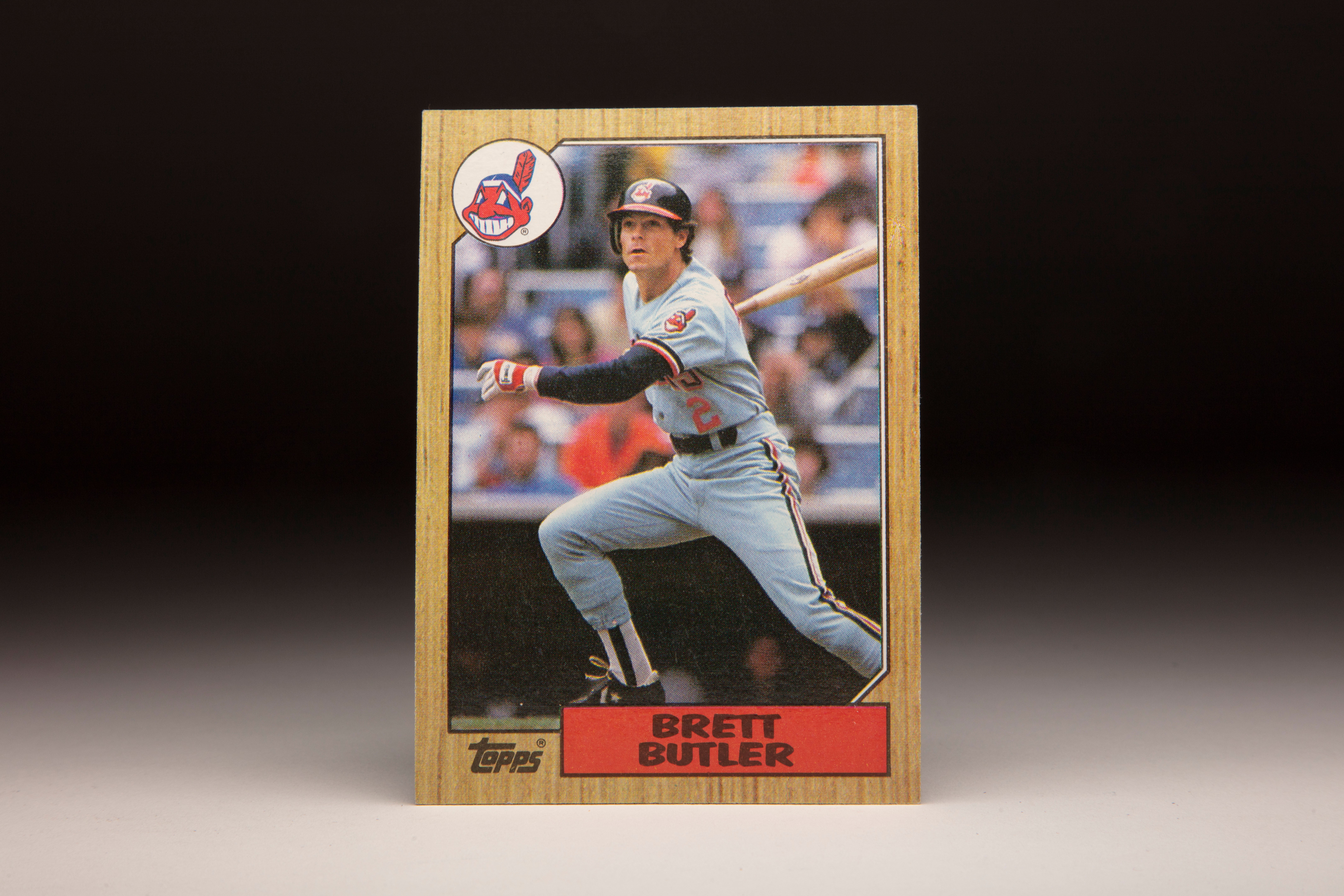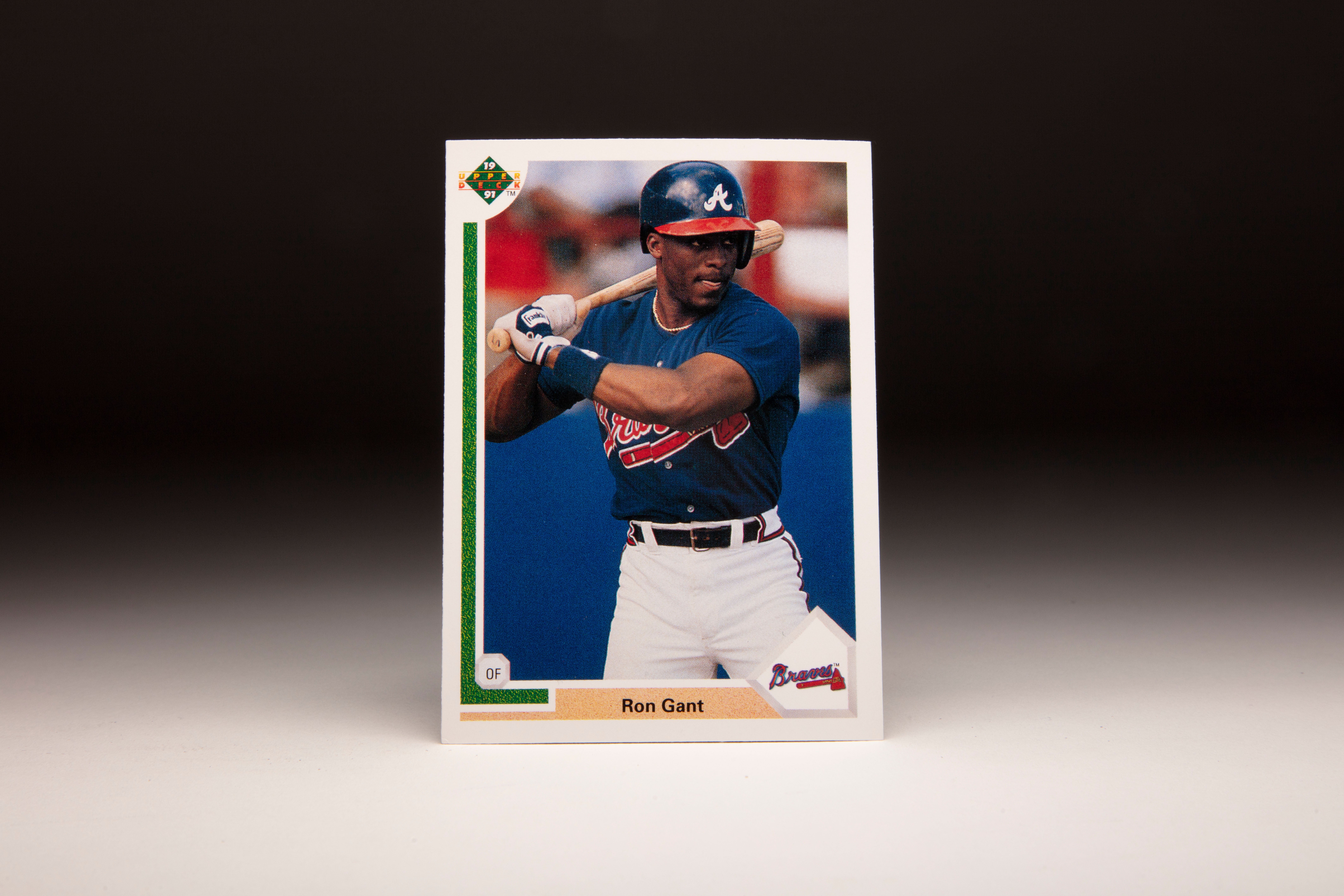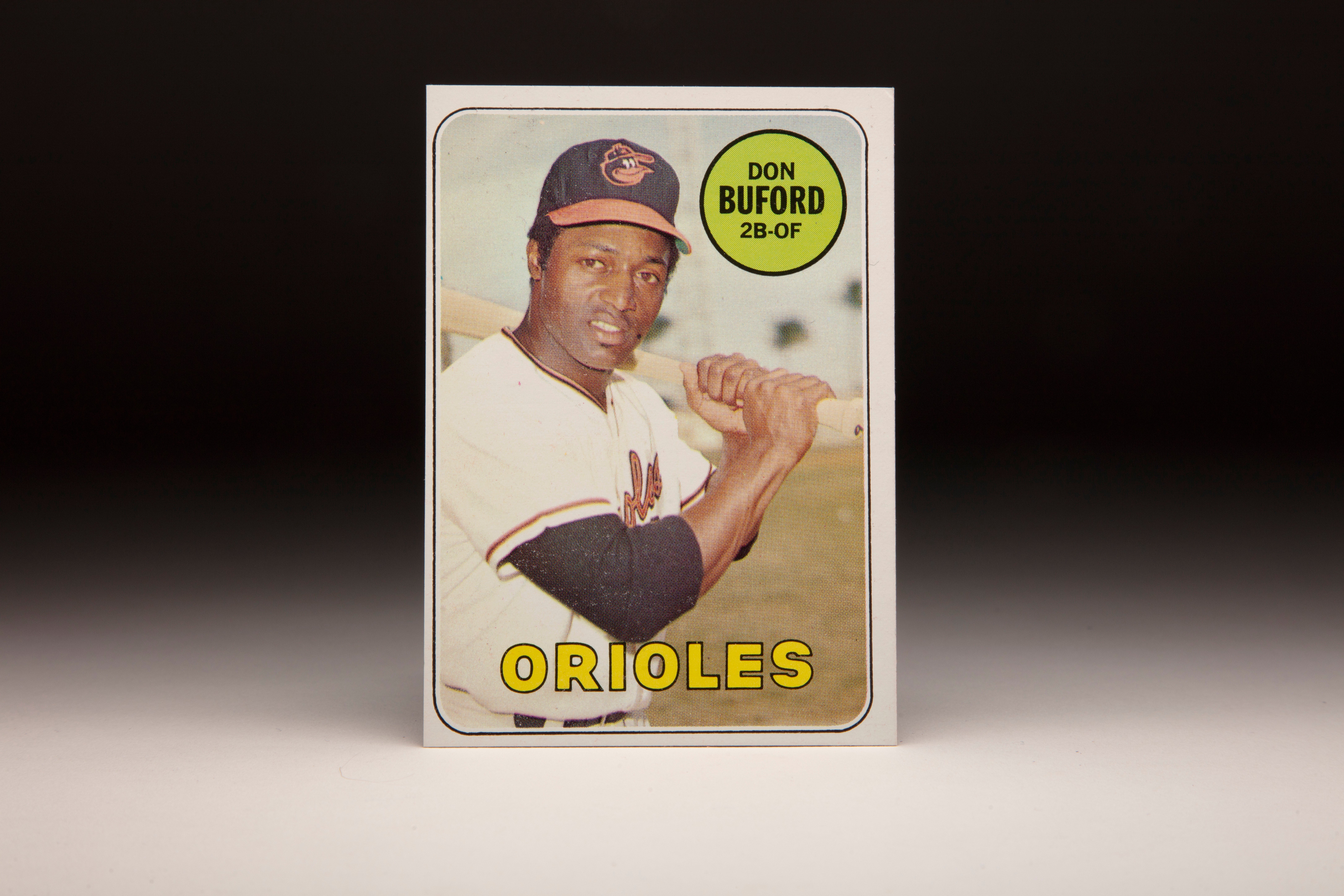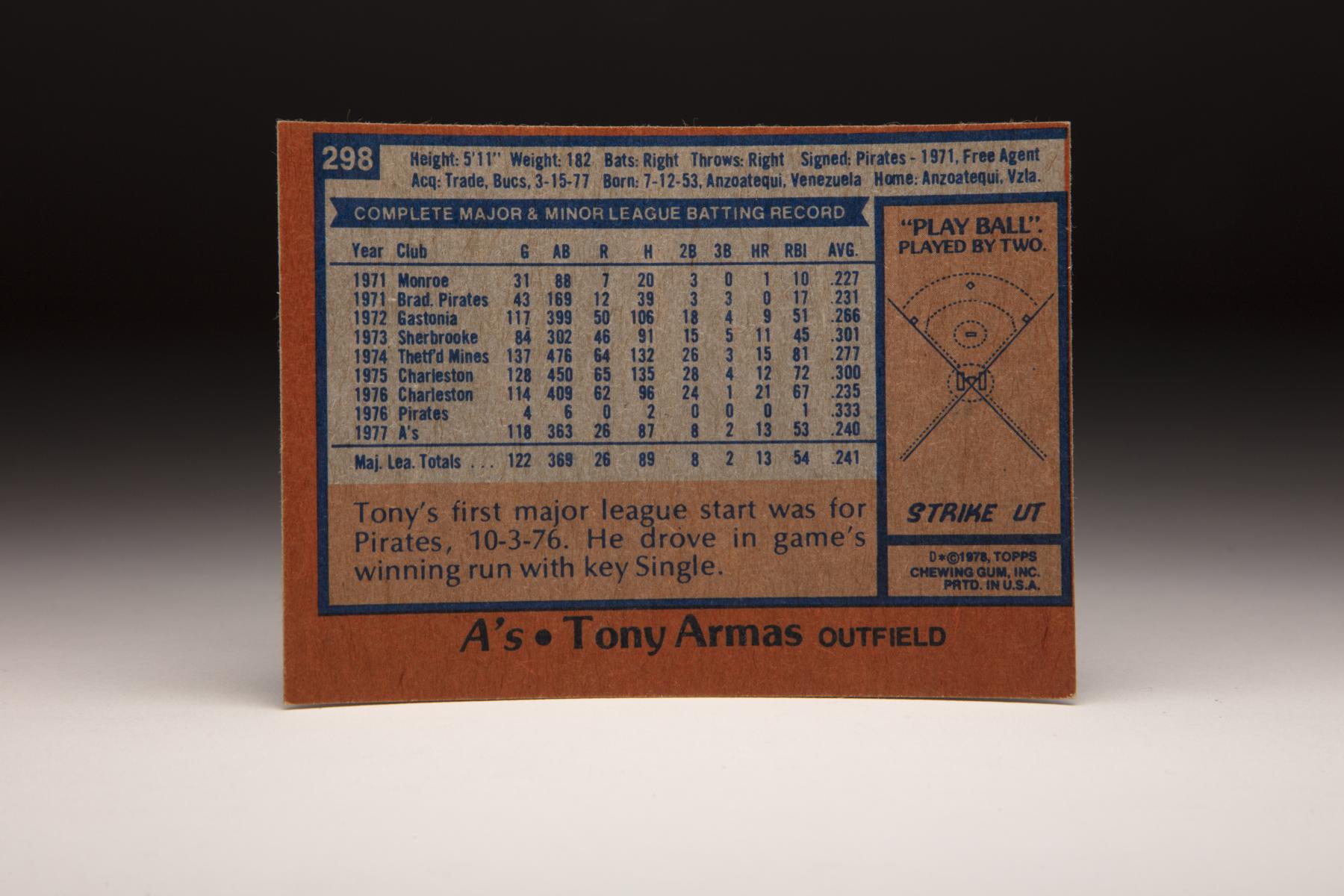- Home
- Our Stories
- #CardCorner: 1978 Topps Tony Armas
#CardCorner: 1978 Topps Tony Armas
The first Venezuelan to lead the AL or NL in home runs, Tony Armas paved the way for future countrymen like Andrés Galarraga and Miguel Cabrera in the big leagues.
Along the way, Armas also had a front-row seat for history with memorable teams in Oakland and Boston.
One of 13 children, Armas was born July 2, 1953, in Puerto Piritu, Venezuela, and grew up in Anzoatequi. His father worked as an electrician, and the family grew fruits and vegetables to keep food on the table. Without access to organized youth leagues to sharpen his skills, Armas played ball in the streets with other children and many adults.
“We used a small, hard rubber ball,” Armas told the Kansas City Star. “We hit it with our hands. If you hit it against any house, it was three outs. Because if it went into somebody’s house, they wouldn’t give it back.”
Armas’ talent soon landed him on the Deportivo Piritu regional team and later the Venezuelan national team. There, Pompeyo “Yo-Yo” Davalillo, who played a handful of games with the Washington Senators in 1953 before becoming a legendary big league scout then working for the Pittsburgh Pirates, took notice of Armas.
“They came to my house and asked me if I wanted to sign,” Armas told the Star. “I was afraid of going to another country by myself and I was afraid my English was not good enough. But my father said: ‘I think my son can do the job. He will sign.’”
On Jan. 18, 1971, Armas signed with the Pirates for a $5,000 bonus. At 17, he was sent to the Pirates’ rookie league team in the Gulf Coast League and later promoted to Monroe of the Western Carolinas League. He ended the 1971 season batting .230 with one home run in 73 games over both levels.
Armas was now a part of a Pirates system flush with young, talented outfielders such as Dave Parker, Richie Zisk and Omar Moreno. As such, his climb to the big leagues was a protracted one.
Armas hit .266 with nine home runs in 117 games for Class A Gastonia of the Western Carolinas League in 1972, then earned a promotion to Double-A Sherbrooke the following year – where he hit .301 in the pitching-rich Eastern League. Armas returned to the EL in 1974 with Thetford Mines, hitting .277 while developing his power with 26 doubles and 15 homers in 137 contests.
Armas earned an invitation the Pirates’ Spring Training camp in 1975 before being shipped to Triple-A Charlestown, where he hit .300 with 12 homers and 72 RBI in 128 games. Slowed by an elbow injury in the spring of 1976, Armas returned to Charleston, where he hit .235 with 21 home runs in 114 games.
But despite the dip in his numbers, Armas was still considered one of Pittsburgh’s top prospects. On Sept. 6, 1976, Armas made his long-awaited big league debut, entering a 6-2 Pirates win over Philadelphia in the ninth inning as a defensive replacement for Zisk in left field. He would not play again for more than two weeks – pinch hitting on Sept. 24 and Sept. 26 – before starting the Bucs’ last game of the season on Oct. 3 in center field. His two-out single to left field off the Cardinals’ Pete Falcone – the second hit of his big league career following a fifth-inning single off Falcone – scored Miguel Diloné to give Pittsburgh a 1-0 walk-off win.
With Armas apparently ready for the big leagues but with no place to play him, the Pirates packaged Armas with five other players – Doug Bair, Dave Giusti, Rick Langford, Doc Medich and Mitchell Page and sent him to the Oakland A’s on March 15, 1977, in exchange for Chris Batton, Phil Garner and Tommy Helms.
It was Garner the Pirates wanted and they paid a heavy price, sending four topnotch prospects – Bair, Langford, Page and Armas – to the Athletics.
“We had talked about Garner for a long time and we were definitely interested in him,” Harding Peterson, who took over as the Pirates’ general manager following the 1976 season, told the Pittsburgh Press. “If the season opens tomorrow, he’s our third baseman.”
Meanwhile, the Athletics – just two seasons removed from their third straight World Series win – were embarking on a total rebuild as free agency decimated owner Charlie Finley’s roster.
Armas won the job as Oakland’s Opening Day right fielder, but struggled at the plate until he was moved to center field in mid-May. He played in 95 of the Athletics’ first 104 games before a knee injury sidelined him for much of August – and Armas finished the year hitting .240 with 13 homers and 53 RBI in 118 games.
“When Tony Armas plays right field, I see some (Roberto) Clemente in him,” Manny Sanguillén, the longtime Pirates catcher who was traded to the A’s following the 1976 season, told the Pittsburgh Press. “He burns that ball. It hurts your hand. It comes in like a cannon.”
Armas was again in the Opening Day lineup as Oakland’s right fielder in 1978 but injured his right knee while backing away from a pitch against the Twins on April 27. He missed the entire month of May and then most of September and finished the year hitting .213 with two homers in 91 games.
Armas opened the 1979 season as Oakland’s center fielder but this time was felled just 10 games into the season when he injured his right knee while charging a ball hit by the Angels’ Rod Carew. He returned in June and played regularly for the next three months until he injured a shoulder diving for a ball against the Tigers, ending his season before September began. In 80 games in 1979, Armas hit .248 with 11 home runs.
But following 1979 season, played winter ball in Venezuela and coach Chico Carrasquel closed his stance, resulting in more power. Manager Felipe Alou convinced him at the same time to hit the ball to right field.
“He told me I was standing too straight,” Armas told the Star of Alou’s advice. “If I crouched, I could reach the ball outside with power.”
Armas was again the Athletics’ Opening Day right fielder in 1980, and this time he started the year hot – pushing his average well over .300 by early May. Healthy all season for the first time in his big league career, Armas finished the year as Oakland’s cleanup hitter and helped power the A’s to a 29-game improvement over their dismal 1979 season. He finished the year with 35 home runs and 109 RBI while hitting .279 and leading all AL right fielders in putouts (351) and assists (15).
His 35 homers bettered the previous single-season record by a Venezuelan player – set in 1979 by the Reds’ Davey Concepción – by 19.
Armas finished 12th in the AL MVP voting and asked an arbitrator to raise his salary more than $450,000 to $500,000. But the arbitrator sided with the Athletics’ offer of $210,000.
Armas struggled during Spring Training, but came alive when the game’s began to count – as did the entire A’s roster. Oakland set a new big league record by beginning the season 11-0 as manager Billy Martin – who had engineered the turnaround in 1980 – pushed all the right buttons.
During that stretch, Armas hit .386 with six homers and 16 RBI.
“I wasn’t concerned at all (about Armas),” Martin told the Associated Press. “I had him in the No. 4 spot in my Opening Day lineup, didn’t I? He’s been doing just great, but so has everyone.”
Armas was hitting .350 as late as May 8 before cooling to a .289 average when the season was interrupted by the strike in June. The A’s were declared the first-half champions with a 37-23 record and Armas played in the All-Star Game when the season resumed on Aug. 9. On Sept. 12, he tied an Oakland A’s record (since surpassed) with 12 total bases (two homers and two doubles) in a game against the Royals.
He finished the season in a four-way tie for the AL homer lead with 22 while hitting .261 with 76 RBI. He would eventually finish a career-best fourth in the AL MVP voting and was named AL Player of the Year by the Sporting News.
In the ALDS vs. the Royals, Armas went 6-for-11 (.545), going 4-for-4 and driving in both runs in Oakland’s Game 2 win as the A’s swept Kansas City in three games. But – battling a groin injury he aggravated against the Royals – he had just two singles in 12 at-bats in the ALCS as the A’s were swept by the Yankees.
In January 1982, Armas signed a new three-year deal worth a reported $2 million. But after another good start to the season, Armas battled a pulled thigh muscle in May and never got untracked – finishing the year with a .233 batting average, 28 homers and 89 RBI.
On Dec. 6, 1982, the A’s parted with their star right fielder, sending Armas and catcher Jeff Newman to the Red Sox for Carney Lansford, Garry Hancock and minor leaguer Jerry King.
Lansford, the 1981 AL batting champion, would go on to be one of the pillars of the Athletics’ dynasty from 1988-92. Armas, meanwhile, would become one of the top power hitters in the game in Boston.
“We gave up one of the premier outfielders for one of the top five players in the game,” A’s executive Bill Rigney told United Press International. “This is the first step in restructuring the Oakland A’s.”
Armas posted fine power numbers in 1983 as the Red Sox’s center fielder, hitting 36 home runs and driving in 107 runs. But his .218 batting average – at the time the lowest batting average ever for a player who totaled at least 100 RBI – and league-leading 31 double play balls made him the target of some Boston boo birds.
“He’s the kind of hitter you’re just going to have to be patient with,” Red Sox manager Ralph Houk told the Boston Globe. “He’ll look bad one time and hit the heck out of the ball the next. Right now, I think he’s got the best arm on the team. I knew before we got him that he was a hitter, but I didn’t find out until this year how good a player he really is.”
In 1984, Armas – with a new batting stance designed by coach Walt Hriniak that encouraged Armas to ignore the Green Monster and hit the ball the other way – pushed his batting average to .268 while leading the majors in home runs (43), RBI (123) and total bases (339). His 164 home runs from 1980-84 were the most of any AL player and trailed only Mike Schmidt (190) overall. He finished seventh in the AL MVP voting, was named to his second All-Star Game and won his first Silver Slugger Award.
With expectations high in 1985, Armas tore a calf muscle in June and played in seven games in June and July. The Red Sox fell out of contention and Armas finished the year with 23 homers and 64 RBI in 103 games.
But in 1986, the Red Sox defied all expectations and won the AL East. With Armas still in center field, Boston held off the Yankees down the stretch even as Armas battled injuries throughout the year. He hit .264 with 11 homers and 58 RBI in 121 games.
In the ALCS vs. the Angels, Armas was removed from Game 5 in the bottom of the fifth inning due to an ailing right ankle. He was replaced in center field by Dave Henderson, whose two-out, ninth-inning home run rallied the Red Sox from the brink in a series they trailed 3-games-to-1. Henderson later hit a sacrifice fly in the 11th inning to give Boston the victory – and the Red Sox won the series in seven games.
Armas did not play in Games 6 or 7.
In the World Series against the Mets, Armas’ only appearance came in Game 7, where he struck out against Roger McDowell in a pinch-hitting role in the top of the seventh. In the bottom of that inning, the Mets scored three times to break a 3-3 tie en route to a victory and the title.
Armas’ contract expired following the World Series, and the Red Sox allowed him to leave Boston. In a winter where an arbitrator eventually ruled that the owners had colluded to keep player salaries down, Armas found no offers.
But he continued to play winter ball in Venezuela – as he did nearly every year – and eventually signed a minor league deal with the Angels on June 30, 1987, and reported to Triple-A Edmonton.
“He can still hit the ball as far as anyone in baseball,” Angels reliever DeWayne Buice, who played winter ball with Armas, told the Los Angeles Times. “He’s unbelievably strong.”
The Angels called up Armas in August, and he hit .198 with three homers and nine RBI in 28 games.
And following a strong spring in 1988, Armas made the Angels’ Opening Day roster. He played 120 games that season, hitting .272 with 13 homers and 49 RBI.
But hamstring and knee injuries plagued Armas in 1989, though he managed to hit .257 with 11 homers and 30 RBI in just 60 games. And after reinjuring the hamstring playing winter ball, Armas retired – though he continued to play winter ball in Venezuela for several years, eventually earning spots in the Caribbean Baseball Hall of Fame and Venezuelan Baseball Hall of Fame.
He finished his big league career with 251 homers – a record for Venezuelan players that stood until Galarraga broke it and before Cabrera surpassed Galarraga – to go along with a .252 batting average and 815 RBI.
In 1993, his younger brother – Marcos – played 15 games for the Athletics. And a son, Tony Armas, pitched 10 seasons with the Expos, Nationals, Pirates and Mets, winning 53 games.
They both followed a standard of excellence set by the former Pirates prospect who battled his way to the majors.
“When you have a brother like Tony Armas,” Marcos Armas told the San Francisco Examiner in 1993, “you like to play better to play like him.”
Craig Muder is the director of communications for the National Baseball Hall of Fame and Museum
Related Stories

#CardCorner: 1987 Topps Brett Butler

#CardCorner: 1991 Upper Deck Ron Gant

#CardCorner: 1985 Topps John Tudor

#CardCorner: 1969 Topps Don Buford

#CardCorner: 1987 Topps Brett Butler

#CardCorner: 1991 Upper Deck Ron Gant

#CardCorner: 1985 Topps John Tudor








